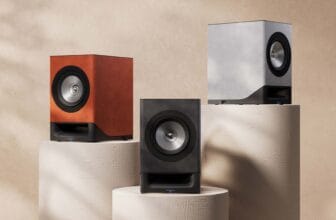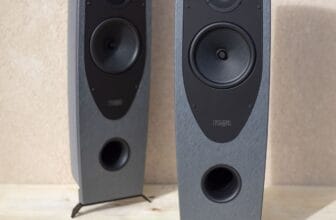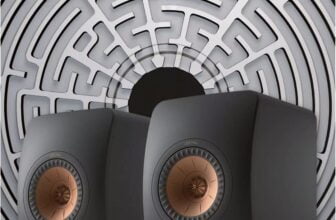Magnepan LRS Review – Little Goes Large
Little in size and price, but large in sonic impact, Magneplanar’s new LRS loudspeaker wows Noel Keywood. Read our Magnepan LRS Review.
At just Magneplanar’s new LRS (Little Ribbon Speaker) is going to have a lot of other loudspeaker manufacturers very worried – but you possibly amazed. I say “possibly” because there are those inevitable negatives I’ll make quite clear that could result in 95% amazement. But the positives of this new panel are so obvious and attractive I suspect a lot of people will be convinced by its charms.
The first positive is price. Panel loudspeakers are at the exotic end of the hi-fi spectrum. I don’t recall any panel coming in at under £, although someone might want to tell me what Gilbert Briggs, founder of Wharfedale, asked for his SFB3 (sand filled baffle) open panel loudspeaker, marketed in the 1950s. Otherwise, you pay good money for an open panel, Martin Logan’s electrostatic panels coming in at more than a few £k. Up till now they have set the standard – and I use one.
Looks like Magnepan would like to change things. I’m taken aback that they should decide to again attempt to make the open baffle loudspeaker popular by slashing price to under the crucial £ mark.
But there’s far more to the LRS. It is not just a cabinet-less open baffle loudspeaker measuring 1 in (2.54cm) thick, but uses Magneplanar’s own magnetic-planar drive units. The whole surface of the loudspeaker moves air, not just one small cone drive unit (or many of them). Increasing radiation area reduces distortion: look at
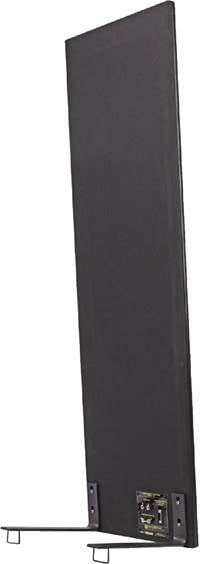
Concorde’s small engine nozzles versus a modern high surface area Trent engine – and hear the difference! The LRS has a wide surface area radiator and you’ll hear how it sounds easier and more relaxed moving air than a small area cone.
To be more specific, what you get in the LRS are two planar (flat) drive units. Each comprises a Mylar film with aluminium conductors on it; you can see them as vertical lines in our pictures. Electrical current passes through these conductors and the resultant magnetic field acts against fixed bar magnets. Sorry for the lecture, but it’s all quite different to the norm and may well become more common in our homes, especially since with a flat panel like the LRS you get something just 1in thick.
To throw in a bit more history, Wharfedale produced an Isodynamic (magnetic planar) headphone in 1972 (checkout Wharfedale Isodynamic at the Victoria & Albert museum) and nowadays everyone is at it, Audeze making good examples. Interestingly, Magnepan’s first loudspeaker, the MG-1, was also released 1972. So the LRS
I’m reviewing here has history behind it. Until recently, and with headphones, magnetic planars have met no great success in the market place but
Magneplanar fit ‘flippers’ (their term, not ours) to optionally tilt the panel forward, changing its tonal balance. The bent iron feet are crude by current standards.
perhaps the LRS could change things.
A great advantage of any open panel is there’s no box to trap the rear sound. What happens in all box loudspeakers (and is never talked about) is that this sound travels back out through the cones. It’s very easy to measure with an impulse, sound decaying for up to 0.3 seconds or so our measurements show – a long time in acoustic terms. You don’t suffer this with an open panel – and you can plainly hear how clean the LRS sounds as a result.
The main disadvantage of any open panel is lack of bass, especially low bass – the rumbly subsonic bits that add underlying weight. The specific disadvantage of magnetic planar drive units is they need a lot of power. The LRS will go loud with 60 Watts but really you need 100 Watts. Happily, 100 Watts comes cheap and good nowadays.
Physically, the LRS is very similar to the .7 and most of my comments in our May 2020 issue review apply. Although delivered in handed (left / right) pairs it’s difficult to distinguish one from the other – and there’s
no name / model badge on the front, which borders on weird; why
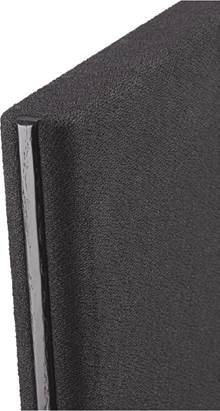
Superficially – a picture of nothing. No box, no fancy bits, not even a name badge. The LRS offers little visually. Yet internally it is both different and complex.
wouldn’t you want to display your name? Obviously, a stick- on badge could be used to identify the tweeter side, solving both problems. As things stand the vertical line tweeter can be identified from front through the grille cloth by its narrower tracks. The LRS lacks the patch beneath the tweeter just visible from front on the .7 and useful for identification.
Size wise and in Imperial measure, because this is a U.S. product, the LRS is 4ft tall, 14in wide and 1 in deep. If that means nothing to you then make it 1 22 cm high, 36 cm wide and 2.5 cm deep. However, the feet extend backwards 1ft (31 cm). Ideally, it should have a few feet (let’s say 60 cm) of rear space to ‘breathe’ and, preferably, some sound absorption / diffusion on a rear wall, examples being a curtain for absorption or a bookshelf for diffusion (dispersion). You can buy acoustic absorption and diffusion panels from StudioSpares for less than £ but such tweaks are not essential, especially if there’s more than 2ft of clear air behind.
Magneplanar fit their own slightly unusual connection panel that accepts 4mm banana plugs and bare wire but you need an adaptor for spades. A removable shorting link can be replaced with a resistor to lower treble, using multiples of 0.47 Ohm I’d suggest (5W carbon film). After a while I did begin to wonder whether some might want to do this with the LRS: it radiates quite a lot of treble power (radiating area, front and rear) and can be a tad forceful up top.
There are funnies like the bent iron bendy feet and flippers to sit the panel upright. An option pack with cast alloy brackets and adjustable spikes/floor pads is needed. I was also a bit intrigued by three damping ‘buttons’ on one speaker but just one on the other. This was a little alarming – left and right looked different – but both were the same in performance, in fact closely matched measurement showed.
If all this seems to make the
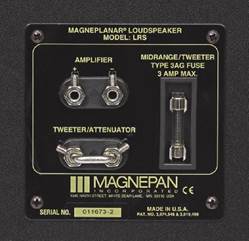
The unusual connecting panel of the LRS. It accepts 4mm plugs or bare wires of 4mm diameter, secured by a hex-key grub screw. The Tweeter/Attenuator link can be replaced by a resistor to reduce treble.
LRS seem a bit exotic, in use it is not. There are no external power supplies, nor any other challenge. They come in a flat box: attach feet, plug-in and go. It’s as simple as that.
SOUND QUALITY
To drive the LRS I used our trusty Creek Evolution 100A (100W) amplifier connected through Chord Company Signature Reference cables. Feeding it was a Chord Electronics Hugo 2 DAC, CDs being spun by our Oppo BDP-205D universal player.
There’s no sound trapped in a rear cabinet to bounce back out through the loudspeaker drive unit and the LRS revealed this with The Pink Panther Theme, where the laconic saxophone introduction cruised in its own nice dark space, free from subliminal background muddle. So think: darkness between notes and a sense of sudden surprise as a riff suddenly comes out of nowhere.
This track also highlighted almost definitive timbral resolution of the sax body, which had a fruitily brassy sound that I suspect its makers had spent enormous effort perfecting, only for it to be lost through most loudspeakers, or even hi-fi systems. Not here: the LRS told me straight away that this sax had body and timbre, with quite a lot of light on it too, to reveal fine nuances. Like listening to a big instrument onto which someone was shining a spotlight.
With Nils Lofgren’s Keith Don’t Go – a test of any loudspeaker – his acoustic guitar strings were bitingly fast I have to say, but with an easy quality my ears did not shrink from. There was also masses of fine internal detail that was almost a shock; this is quite a dramatic loudspeaker if you turn the volume up – as I suspect most will. If too many bats fall dead in your living room (dare I mention them!) then treble level can be reduced with a resistor.
“masses of fine internal detail that was almost a shock”
As Sinead O’Connor drops into barren lament at the end of Foggy Dew her stark, unaccompanied vocal was eerily present against the background acoustic of the studio being picked up by the mic. It made for dramatic listening, the LRS doing not just a fine job here but one notches above all else – except Martin Logan’s XStat electrostatic panel.
A big no-no with open panel loudspeakers like the LRS is they don’t deliver deep bass. Magnepan have twiddled the LRS to sound full-bodied and bass rich, but when I span Loreena McKennit’s ‘Gates of Istanbul’ the opening bass line lacked deep rumble. The LRS has a hard cut-off of deep notes so it sounds big and warm – but won’t be shaking the foundations. Smaller rooms than ours will however give stronger deep bass. A room around 18ft long would be ideal.
Imaging across the sound stage was fabulous. Dadawa singing Canton Story hovered clearly centre stage. The sax in the Pink Panther theme similarly had position chiselled in stone.
Downsides? Yes, they are always there. Being totally absorbed by the LRS I used it hard. After a while some understanding emerged as to the difference between it and an electrostatic panel. The LRS has a slight metallic colour, reminiscent of a metal cone loudspeaker, that contributes to its sense of speed and hardness. An electrostatic like Martin Logan’s XStat panel has a lighter, more ethereal sound. I suspect the LRS will appeal to those who want ‘fast’ Rock, rather than those demanding absolute tonal purity from Classical instruments.
CONCLUSION
What a proposition! A small panel loudspeaker for under £. And with magnetic planar drive units. Totally different to all else at this price and
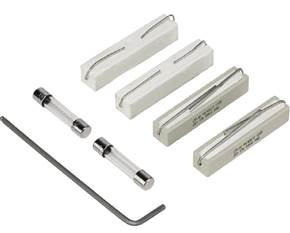
Supplied are two fuses, plus a Hex key and four resistors, 2 x 1.2 Ohm, 2 x 2 Ohm, for reducing treble level. They are 10W wirewounds.
quite radical in its sound, the new Magneplanar LRS or Little Ribbon Speaker, from Magnepan (USA), is in many areas streets ahead of conventional box loudspeakers. Clearer by far and with superb sound staging and imaging, also far more coherent so singers and instruments are more “one of a piece”.
There was some warmth, strong upper treble (but this is adjustable) and good if not deep bass, at least in our large listening room. In smaller rooms (circa 1 6ft long) bass would likely be stronger.
With a different sonic to all else, the LRS I found riveting. Very, very worth hearing. Try and get a demo.
MEASURED PERFORMANCE
Frequency response of the Magneplanar LRS measured reasonably flat in overall trend across most forward measuringmicrophone positions. Our third-octave analysis of pink noise shown here was made centrally on-axis, in front of a small disc visible behind the front grille cloth, approximately ear height with the feet ‘flippers’ down to make the panel stand upright.
There is some emphasis of low frequencies, as there needs to be in a panel loudspeaker to add a sense of body to the sound. The vertical ribbon tweeter extends smoothly to 16kHz and the midrange dip seen here all but disappeared with the microphone moved to the side opposite to the tweeter, suggesting the ribbon tweeter should be on the outside of what are handed-pair loudspeakers (i.e. left and right), unlike the .7 reviewed in our May 2020 issue.
Bass extends down to 50Hz so the LRS reproduces low frequencies in spite of its limited width. The bass panel works up to 800Hz, measurement showed, leaving the ribbon tweeter to cover a lot of the audio band (800Hz-16kHz).
At rear a removable link couples the treble unit. It can be replaced by a 0.47 Ohm or 1 Ohm resistor to pull down high frequency output if desired.
As an amplifier load the LRS is effectively a 3.5 Ohm resistor, our impedance plot shows. In spite of this low value the speaker is insensitive, producing just 80dB sound pressure level (SPL) at one metre; it needs an amplifier of 60 Watts to go reasonably loud and 100 Watts is probably a better choice.
The LRS has a reasonably accurate tonal balance with quite strong upper treble. It will sound a tad warmer than many modern box speakers and needs a powerful amplifier for high volume.
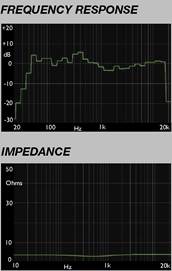
MAGNEPLANAR LRS
OUTSTANDING – amongst the best
VALUE – keenly priced
VERDICT
Decent Audio +44 (0)56 0205 4669 www.decentaudio.co.uk


